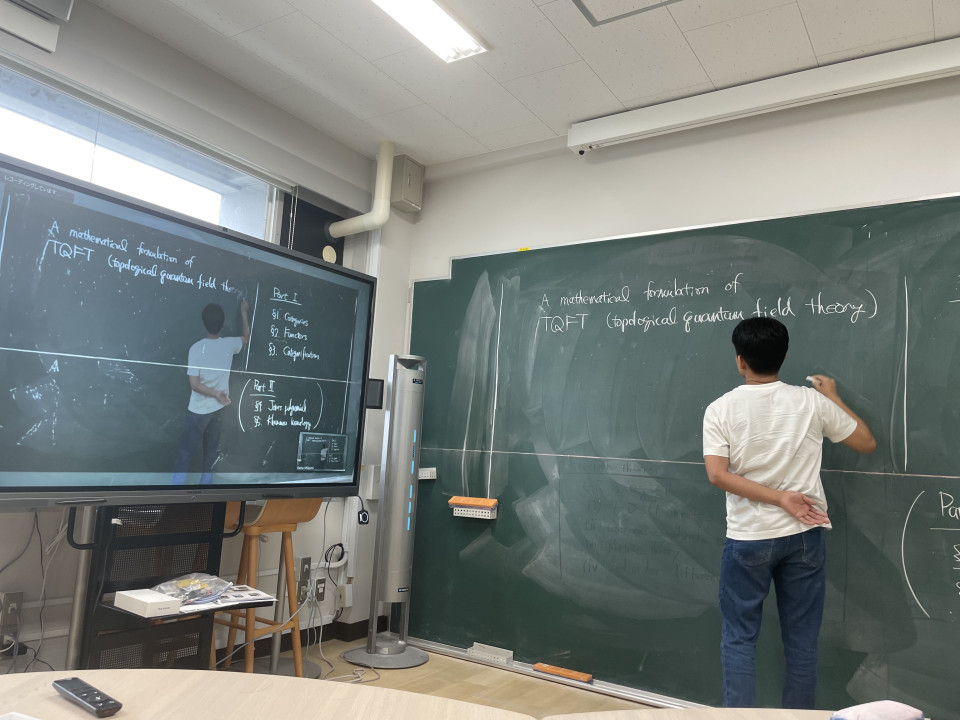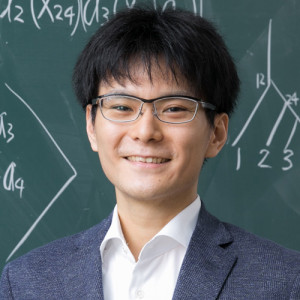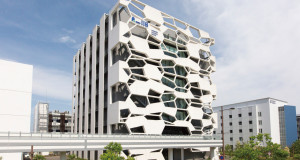Volume 199
Back to Newsletter List
Seminar Report
iTHEMS Math Seminar by Dr. Taketo Sano on May 13, 2022
2022-05-18
In May 13, there was a math seminar by Taketo Sano. He gave an introductory talk on category theory.
Reported by Keita Mikami
Khovanov homology theory - an introduction to categorification
May 13 (Fri) 14:00 - 16:30, 2022
Upcoming Events
Seminar
iTHEMS Math Seminar
A mathematical formulation of two-dimensional conformal field theory
May 23 (Mon) 14:00 - 16:30, 2022
Yuto Moriwaki (Special Postdoctoral Researcher, RIKEN Interdisciplinary Theoretical and Mathematical Sciences Program (iTHEMS))
The mathematical construction of non-trivial quantum field theory in four dimensions, known as the "Yang-Mills existence and mass gap problem", is a very important issue in mathematical sciences. There are many examples of rigorous quantum field theories in two dimensions, although the four dimensions have not yet been solved. In particular, two-dimensional conformal field theory, which is a quantum field theory with conformal symmetry, has good properties and can be formulated mathematically using algebraic structures formed by "products of a field and a field" (operator product expansion).
In this talk, this algebraic formulation (full vertex algebra) will be explained. Various construction methods and concrete examples (construction using codes, construction from quantum groups, and construction by deformation) will then be discussed.
All the talk here is mathematical, but I will try to speak in a way that is motivated by physics as much as possible throughout the talk. I hope to receive various comments from the viewpoints of other fields.
Venue: Hybrid Format (Common Room 246-248 and Zoom)
Event Official Language: English
Seminar
Quantum Matter Seminar
Introduction to Topological Insulators: The Ten-fold Classification of Topological Insulators and Superconductors Part.1
May 24 (Tue) 14:00 - 15:30, 2022
Ching-Kai Chiu (Senior Research Scientist, RIKEN Interdisciplinary Theoretical and Mathematical Sciences Program (iTHEMS))
References
- Andreas P. Schnyder, Shinsei Ryu, Akira Furusaki, and Andreas W. W. Ludwig, Classification of topological insulators and superconductors in three spatial dimensions, Phys. Rev. B 78, 195125 (2008), doi: 10.1103/PhysRevB.78.195125
- Alexei Kitaev, Periodic table for topological insulators and superconductors, AIP Conference Proceedings 1134, 22 (2009), doi: 10.1063/1.3149495
Venue: via Zoom
Event Official Language: English
Seminar
NEW WG Seminar
Equilibrium or not? Mathematical differences between acute & chronic virus infections
May 25 (Wed) 13:30 - 15:00, 2022
Catherine Beauchemin (Deputy Program Director, RIKEN Interdisciplinary Theoretical and Mathematical Sciences Program (iTHEMS))
The widely acclaimed 1995/1996 papers by Ho, Perelson and others [1,2] demonstrated the important insights that come from mathematical modelling of virus infection kinetics within a person. But there are key dynamical differences between chronic and acute infections, namely whether the infection reaches or maintains some equilibrium or not. In this talk, I will introduce the equations used to describe a virus infection within a person. I will show some of the tricks used by mathematical modellers to extract important rate estimates from measurements in patients infected with chronic diseases, like HIV or Hepatitis C virus. I will explain why it is difficult to extract meaningful information from measurements in patients with an acute infection, like influenza or possibly COVID-19 [3]. I hope to hear from the audience if they have any thoughts about overcoming the issue to extract better rate information from limited data in patients with acute infections.
(This seminar is a joint seminar between Nonequilibrium working group and Biology study group)
References
- Ho DD, Neumann AU, Perelson AS, Chen W, Leonard JM, Markowitz M., Rapid turnover of plasma virions and CD4 lymphocytes in HIV-1 infection, Nature 373 (6510) 123-6 (1995), doi: 10.1038/373123a0
- Perelson AS, Neumann AU, Markowitz M, Leonard JM, Ho DD, HIV-1 dynamics in vivo: virion clearance rate, infected cell life-span, and viral generation time, Science (1996), doi: 10.1126/science.271.5255.1582
- Palmer J, Dobrovolny HM, and Beauchemin CAA, The in vivo efficacy of neuraminidase inhibitors cannot be determined from the decay rates of influenza viral titers observed in treated patients, Sci. Rep., 7:40210 (2017), doi: doi:10.1038/srep40210
Venue: via Zoom
Event Official Language: English
Seminar
ABBL-iTHEMS Joint Astro Seminar
Core-collapse Supernova Models with Heavy Axion-like Particles
June 3 (Fri) 14:00 - 15:00, 2022
Kanji Mori (Research Institute of Stellar Explosive Phenomena (REISEP), Fukuoka University)
Axion-like particles (ALPs) are a class of hypothetical bosons which feebly interact with ordinary matter. The hot plasma of stars and core-collapse supernovae is a possible laboratory to explore physics beyond the standard model including ALPs. Once produced in a supernova, some of the ALPs can be absorbed by the supernova matter and affect energy transfer. We recently calculated the ALP emission in core-collapse supernovae and the backreaction on supernova dynamics consistently. It is found that the stalled bounce shock can be revived if the coupling between ALPs and photons is as high as $g_{a\gamma}\sim 10^{-9}$ GeV$^{-1}$ and the ALP mass is 40-400 MeV.
Venue: via Zoom
Event Official Language: English
Seminar
DMWG Seminar
Cosmological phenomena with sterile neutrino
June 6 (Mon) 16:30 - 18:00, 2022
Shintaro Eijima (Institute for Cosmic Ray Research (ICRR), The University of Tokyo)
Event Official Language: English
Seminar
NEW WG Seminar
Non-Abelian vortices in two-flavor dense QCD
June 15 (Wed) 13:30 - 15:00, 2022
Yuki Fujimoto (Postdoctoral Scholars, Department of Physics, University of Washington, USA)
Recently, the phase of the two-flavor quark matter with the new
pattern of color superconductivity was proposed so that the continuous
crossover from the hadronic to the quark phase is realized [1]; it is
in consonance with the recent observation of neutron stars.
In this talk, I will show the classification of the topological
vortices in this phase. We found that the stable vortices are what we
call the "non-Abelian Alice strings" [2]. They are superfluid
vortices carrying 1/3 quantized circulation and color magnetic fluxes.
I will discuss their properties in comparison to the well-established
CFL vortices in three-flavor symmetric setup, by putting some emphasis
on their peculiarity: the non-Abelian generalization of the Alice
property. I will then discuss in detail the possibility that these
vortices are confined as well as how the vortices in the quark phase
can be connected to those in the hadronic phase [3].
[1] Y. Fujimoto, K. Fukushima, W. Weise, PRD 101, 094009 (2020) [1908.09360].
[2] Y. Fujimoto, M. Nitta, PRD 103, 054002 (2021) [2011.09947]; JHEP 09 (2021) 192 [2103.15185].
[3] Y. Fujimoto, M. Nitta, PRD 103, 114003 (2021) [2102.12928].
Venue: via Zoom
Event Official Language: English
Seminar
iTHEMS Theoretical Physics Seminar
Dress code for infrared safe S-matrix in QED
June 22 (Wed) 13:30 - 15:00, 2022
Sotaro Sugishita (Designated Assistant Professor, Institute for Advanced Research (IAR), Nagoya University)
We consider the infrared (IR) aspects of the gauge invariant S-matrix in QED. I will review the problem of IR divergences in QED, and introduce the dressed state formalism to obtain IR-safe S-matrix elements. I will show a condition for dressed states to obtain IR-safe S-matrix elements, and explain that this condition can be interpreted as the memory effect and is related to asymptotic symmetry. I also explain that IR divergences are necessary to prohibit the violation of asymptotic symmetry. We also argue that the difference between dressed and undressed states can be observed, even if we are able to observe an inclusive cross-section summing over soft photons.
Venue: Hybrid Format (Common Room 246-248 and Zoom)
Event Official Language: English
Seminar
NEW WG Seminar
Superconducting-like heat current: Effective cancellation of current-dissipation trade-off by quantum coherence
July 25 (Mon) 13:30 - 15:00, 2022
Tajima Hiroyasu (Assistant Professor, Graduate School of Informatics and Engineering, The University of Electro-Communications)
Recent developments in statistical mechanics have revealed a tradeoff between heat current and dissipation [1,2]. In various situations, this current-dissipation tradeoff represents a relationship between thermal energy flow and entropy increase, similar to Joule’s law W=RI^2.
On the other hand, the coherence effect on the current-dissipation tradeoff has not been thoroughly analyzed. Here, we systematically analyze how coherence affects the current-dissipation tradeoff [3]. The results can be summarized in the following three rules:
- Quantum coherence between different energy levels strengthens the trade-off. In other words, the ratio between the square of the heat current and the entropy production ratio corresponding to electrical resistance R (hereafter referred to as "thermal resistance") is increased by the superposition of different energy levels.
- Coherence between degeneracies weakens the trade-off. That is, thermal resistance is weakened by coherence between degeneracies.
- With enough coherence between degeneracies, we can cancel the trade-off effectively and make the thermal resistance approximately zero. Then, macroscopic heat flow without entropy increase is realized.
These three results directly reveal the coherence effects on heat engine performance. That is, coherence between different energy levels reduces the performance, while coherence between degeneracies increases it. And when there is a sufficient amount of coherence between degeneracies, the efficiency can asymptotically reach the Carnot efficiency (η=η_{Car}-O(1/N)) while the power is O(N).
References
- N. Shiraishi, K. Saito, H. Tasaki, Universal Trade-Off Relation between Power and Efficiency for Heat Engines, Phys. Rev. Lett. 117, 190601 (2016), doi: 10.1103/PhysRevLett.117.190601
- A. C. Barato, U. Seifert, Thermodynamic Uncertainty Relation for Biomolecular Processes, Phys. Rev. Lett. 114, 158101 (2015), doi: 10.1103/PhysRevLett.114.158101
- H. Tajima, K. Funo, Superconducting-like Heat Current: Effective Cancellation of Current-Dissipation Trade-Off by Quantum Coherence, Phys. Rev. Lett. 127, 190604 (2021), doi: 10.1103/PhysRevLett.127.190604
Venue: via Zoom
Event Official Language: English
Workshop
DM3 - Deep insights and Multiple strategies for Deciphering the Mystery of Dark Matter
September 15 (Thu) - 17 (Sat) 2022
Venue: SUURI-COOL (Kobe), Room S704-S705, Integrated Innovation Building (IIB), Kobe Campus, RIKEN / via Zoom
Event Official Language: English
Paper of the Week
Week 4, May 2022
2022-05-19
Title: Gyrohydrodynamics: Relativistic spinful fluid with strong vorticity
Author: Zheng Cao, Koichi Hattori, Masaru Hongo, Xu-Guang Huang, Hidetoshi Taya
arXiv: http://arxiv.org/abs/2205.08051v1
Title: Event reconstruction of Compton telescopes using a multi-task neural network
Author: Satoshi Takashima, Hirokazu Odaka, Hiroki Yoneda, Yuto Ichinohe, Aya Bamba, Tsuguo Aramaki, Yoshiyuki Inoue
arXiv: http://arxiv.org/abs/2205.08082v1
Title: Running Hubble constant from the SNe Ia Pantheon sample?
Author: Tiziano Schiavone, Giovanni Montani, Maria Giovanna Dainotti, Biagio De Simone, Enrico Rinaldi, Gaetano Lambiase
arXiv: http://arxiv.org/abs/2205.07033v1
Title: The Prime Number Theorem and Pair Correlation of Zeros of the Riemann Zeta-Function
Author: D. A. Goldston, Ade Irma Suriajaya
arXiv: http://arxiv.org/abs/2205.06503v1
If you would like to cancel your subscription or change your email address,
please let us know via our contact form.
Copyright © iTHEMS, RIKEN. All rights reserved.








